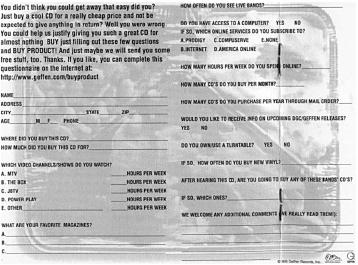| 19 | Marketing Research |
Marketing research is important in every aspect of marketing recorded music. Research is used to find out about the marketplace, about who is buying what products, and what they like and dislike about existing products in the marketplace. Basically, marketing research is conducted to learn more about the market and to learn how to improve the product. Chapter 1 outlined how diffusion theory can be applied to improve upon products and make them more appealing in the marketplace. Marketers learn from research what the most popular product attributes are for each market segment, and then they retool the product and the promotional messages to focus on those attributes. For example, toothpaste users can be segmented into those whose choices are driven by ability to: (1) whiten teeth, (2) freshen breath, (3) fight cavities, (4) fight gum disease, and so forth. It is research that gives marketers the insight into who wants what.
Marketing research is defined as the systematic design, collection, analysis, and reporting of data and findings relevant to a specific situation facing a company (Blankenship, A.B. and Breen, G.E., 1993). The American Marketing Association describes it as “marketing research links the consumer, customer and public through information—information used to identify and define marketing opportunities and problems; generate, refine, and evaluate marketing actions; monitor marketing performance; and improve understanding of marketing as a process.”
The information gathered with marketing research helps companies make marketing decisions; decisions about where to advertise, how to allocate the marketing budget, how to craft marketing messages, and how to present the product in the marketplace.
Much of what is done for research is designed to predict future behavior of consumers. Research is commonly conducted using samples, a small representative subsection of the market segment. Then, the findings are generalized to the entire market segment. Sampling is done because of the physical impossibility of interviewing, measuring, or monitoring every member of a market segment. Therefore, much of the information reported in research findings, being predictive in nature, has a preset level of margin of error: the level of uncertainty associated with the research. Margin of error is usually expressed as a plus or minus factor, for example 75% ± 2% (see section on research validity).
“Research is conducted for so many reasons:
- To check out a new product orconcept idea,
- To ask consumers what theythink of an artist’s new singles, videos, image changes,
- To touch base with a particularconsumer group, either genre ordemographic-based to see whatthey are thinking about artists, radio, video play,
- To ask questions about howmusic is fitting into people’slifestyles as compared to other entertainment items likevideogames, movies, DVD, cellphones, etc.,
- To understand better therelationship between an artistand other brands.”
- Linda Ury Greenberg
VP, Sony BMG Consumer Research
![]() Figure 19.1 Why marketing research is conducted
Figure 19.1 Why marketing research is conducted
Another aspect of marketing research involves collecting data on previous sales patterns and then projecting that to future sales, whether it’s the same products or similar products. SoundScan data is used to examine sales of one release to help guide and shape the marketing decisions of other releases. Researchers also use test marketing: introducing the product into a small portion of the marketplace and monitoring sales before financing a large scale release.
Syndicated vs. custom research
The two basic categories of marketing research are syndicated and custom. Syndicated research is the gathering of continuous or periodic information that is sold in standardized form to all companies involved in the industry. Examples include the work of Arbitron, Nielsen, BDS and SoundScan. Custom research is usually tailored, proprietary, initiated by a company, and often specific to a particular product developed by that company. Examples include product surveys (found inside the product or attached to the warranty card), focus groups, customer satisfaction surveys and personal interviews.
There are six stages to the research process, starting with identifying the problem that must be researched. Through the subsequent stages, the research project is shaped and designed to discover ways to overcome the marketing challenge or problem.
1. Problem identification—Before a survey is developed, or a research project is designed, the questions to be addressed by the project must be identified. Stage one begins with a definition of the marketing problem. This leads to a preliminary statement of research objectives. The goals of the research may include a description of the market, a prediction of how the product will perform in the marketplace, or an evaluation of the product or a portion of the marketing plan. For example, before marketing the release of a new album, the marketing department may wish to learn more about the target market: what they read, where they hang out, how they find out about new music, and so on.
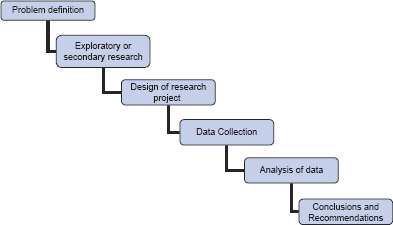
![]() Figure 19.2 The research process
Figure 19.2 The research process
2. Exploratory/secondary research—Stage two involves finding out what has already been learned on the topic, and what information is already available. This is known as secondary research, defined as going over data that has been previously collected for a project other than this one at hand (Zikmund, W. G, 1991). Examining previous research is necessary to avoid repeating mistakes and to gain an underlying knowledge of the area of study. This helps guide the researcher toward the type of project that will most likely address the research questions, so that in stage three, the research project is designed.
Exploratory research is defined as initial research conducted to clarify and define the nature of the problem. It is done to help diagnose the situation, to allow for screening of alternatives, and to discover new ideas. Concept testing is frequently done in exploratory research. Concept testing is a means of evaluating ideas by providing an early indicator of the merits of an idea prior to the commitment of resources to development and manufacturing—in other words, a prototype. Some record labels will concept test music earmarked for an upcoming album before deciding which songs should be included and which should not.
3. Design of research project—The three most popular research designs are experiments, descriptive, and qualitative (focus groups).
Experiments are designed primarily to determine cause and effect. For example, experiments were conducted in the 1960s and 70s to determine if smoking cigarettes caused lung cancer. Ongoing research experiments seek to determine if observing violence on television increases the likelihood of aggressive behavior. Experiments usually involve an experimental group and a control group. The experimental group gets the treatment (cause), or is subjected to the marketing program, and the control group is not. In marketing, experiments may be conducted by placing product or promotional materials in particular locations in some stores, and other locations in similar stores, and then monitoring the differences in sales. Or, finding similar geographic units or markets and implementing advertising plan A in one market and plan B in another.
Descriptive research is designed to describe something, and is often used to describe the market. Surveys are the most common instrument used in descriptive studies. Consumers are asked questions about who they are, what they like and what they do. Record labels commonly use consumer reply cards embedded in CD jewel cases to survey consumers. Questions are designed to provide information of value to marketers. For example, the following survey questions are designed to guide marketers or identify consumers in particular ways.
Table 19.1 Survey questions and research goals
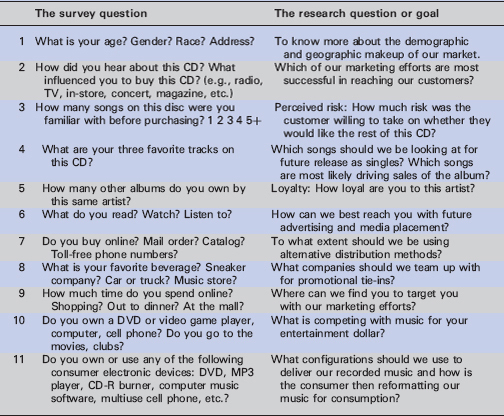

![]() Figure19.3 Sample consumer survey
Figure19.3 Sample consumer survey
Focus groups, or other qualitative methods such as personal interviews, are used when marketers want more in-depth information from the market. Focus groups are unstructured, free-flowing group interviews designed to gain a deeper understanding of consumer feelings, beliefs, and attitudes. Responses to questions can be probed with further questioning to find out why consumers hold these attitudes. Focus groups are good for test marketing new music and finding out why consumers like or dislike certain songs. They are not good for generalizing and providing statistical data about a market.
Table 19.2 Research design
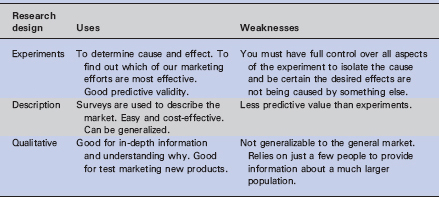
For greater accuracy, sometimes triangulation is used where two methods are employed and if findings are consistent, researchers are more confident in the results. Triangulation is the application and combination of several research methodologies in the study of the same phenomenon (Zulkardi, 2004). By looking at something from two different angles, more accurate conclusions can be drawn.
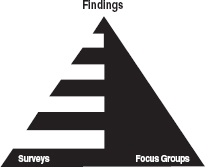
![]() Figure 19.4 Triangulation
Figure 19.4 Triangulation
4. Data collection—Data are collected by conducting the experiment, survey or focus groups. Once the design has been determined, a sample must be selected. Rarely does a research project rely on a census (a measure of everyone in the population or market) because of the costs involved in collecting the data. Therefore, a sample is selected to represent the market, and data are collected from this sample.
Sampling must be scientific and follow certain guidelines, known as sample design. This includes the method of selection, the sample structure and plans for analyzing and interpreting the results (Tutor2U, 2005). Common folklore has people believing that population size is very important in determining sample size. In other words, if I want to generalize to the entire U.S. population, I would need a larger sample than if I wanted to generalize to all college students. This is not true. Population size does not normally affect sample size. But the sample does have to be proportionally representative of the population, known as sampling frame. For example, if I wanted to know what high school males and females thought about algebra, it would not be wise to conduct the survey of female shoppers in the mall during regular school hours. Instead, I would need to sample a certain number of high school males and females; the proportion of males to females would be dependent upon the proportion in the population. The sampling frame must be representative of the population, and is defined as a list of elements from which a sample may be drawn. Often these elements can be identified by existing information. For presidential election polls, the sampling frame would be all registered voters, or likely voters.
There are two phases in the process of gathering data: the pre-testing phase and the main study. Pre-testing is done to ensure the validity of the instrument (i.e., a survey) used to measure the research issues. After pre-testing, the revised survey is administered, or the experiment performed, or the focus groups are conducted. The data must then be converted into a form that allows for systematic analysis, whether that be numerical data that is input into a program, or recordings and transcripts of interviews and focus groups for analysis.
5. Analysis of data—Data analysis begins with editing and coding. Editing involves checking the data collection forms for omissions, legibility and consistency in classification, especially for fill-in-the-blank questions. The data are then coded. Coding refers to the systematic process of interpreting, categorizing, recording and transferring the data to the data processing program. Data analysis is the application of logic to the data, looking for systematic patterns and details that will answer the research questions.
The appropriate analytical technique is determined by the survey design. Surveys are generally analyzed using a statistical software program. Interviews and focus groups are often transcribed, and sometimes software is used to look for key terms in the text and identify patterns of responses. In experiments, the experimental variable (i.e., the presence or absence of cancer in smokers, presence or absence of aggressive behavior after watching violence on television) is measured with the appropriate instruments.
6. Conclusions and recommendations—The research report is the main tool for communicating the findings and recommendations from the research company to the client. A research report is an oral presentation and/or written report, and the purpose is to communicate the results, findings, and recommendations to the marketing client. The research report states the conclusions from the data analysis, first as straight-forward responses to the measurements. These are then compared to the original research questions and goals to make sweeping conclu-sions and recommendations. A typical written report contains an executive summary, and introduction (including objectives), methodology, the literal results, and conclusions and recommendations. The executive summary is a one or two page bulleted-list summary of the highlights of the findings. It is designed to be read by those people who need to know the main points, but do not have time to read through the report to find them.
Caution must be taken to ensure any research project is valid. Validity is a term that describes the ability of a research project to measure what was intended to be measured. If the goal is to measure purchase behavior, asking questions about attitude toward various products may not provide a valid measurement of their likelihood to actually purchase the product. Consumers may have a more positive attitude toward a product that they have no intention of buying because of the price or some other factor. Instead, questions should be asked about actual purchase behavior and purchase intention.
There are three approaches to establishing validity: face or content validity, criterion validity, and construct validity. Face validity refers to a subjective understanding among experts that the research design and measurement logically appear to actually measure what it intends to measure, (i.e., Does it logically make sense?). Criterion validity relies on what has been done in other studies and whether it meets common standards, (i.e., Is this the way similar research has been successfully conducted in the past?). Construct validity is the ability of a measure to provide empirical evidence consistent with a theory based on the concepts. Often in marketing research, the marketing client will have expectations of the possible outcomes of a research project, based upon theory.
Confidence level and margin of error
Because almost all research involves taking a sample of the market rather than measuring everyone, there is the possibility of some error—that is, the findings from the sample are not exactly what occur in nature. The margin of error, which is the plus or minus three percentage points seen after percentages are listed in reporting results, has to do with the probability that the findings represented by the sample will be true for the population at large. In other words, if a result is presented as 36% ±3%, it means that while the sample found a result of 36%, there is a strong likelihood that in the population, the true result is between 33% and 39%. The margin of error decreases as the size of the sample increases, but only to a point. Researchers generally weigh the risk of error against the additional costs required to fund research for a larger, more accurate sample. The level of confidence is a measure of how confident we are in a given margin of error, and the general acceptable standard is a 95% level of confidence with a margin of error of ±2 or 3%. (For example, if we ran this experiment 100 times, it would produce findings within the margin of error 95 times.)
Table 19.3 Margin of error |
|
Survey sample size |
Margin of error percent* |
2,000 |
2 |
1,500 |
3 |
1,000 |
3 |
900 |
3 |
800 |
3 |
700 |
4 |
600 |
4 |
500 |
4 |
400 |
5 |
300 |
6 |
200 |
7 |
100 |
10 |
50 |
14 |
|
*Assumes a 95% level of confidence | |
The application of research principles
Marketing researchers must have an understanding of when to use various research designs and measurements, and also when they may not be appropriate.
When focus groups are appropriate
Focus groups are considered exploratory research, but can be conducted either before a full-scale survey is launched, in conjunction with a survey, subsequent to a survey, or in rare cases, as a stand-alone research project. Focus groups are usually conducted before a major survey in order to gain an understanding of the target market for the survey. The group interviews help the researcher understand context, vernacular, and how various survey questions will be interpreted.
When triangulation is advised, focus groups may be run in conjunction with a survey, with the survey providing the information to be generalized to the population and the focus groups providing depth of understanding to the responses. Occasionally, focus groups are conducted after a survey is completed, especially if there are lingering questions about the findings that need clarification from members of the market. Stand-alone focus groups are conducted when researchers want some insight into the minds of the consumers, but do not need quantitative data and do not intend to generalize the findings to the larger population.
Focus groups are good for concept testing. Record labels use them to judge consumer opinions about artists and their music, their appearance, the quality of the recordings, the lyrics, and the artist image. In these situations, focus group attendees are exposed to elements of the marketing plan (the music, video, photos, and so on) in a controlled setting, and reactions to these elements are noted. The groups can be conducted early in the project, before the music has been finalized for the release and before imaging materials have been selected. The attendees may be presented with photos of the artist with different looks, and then asked to comment on each one. They may also be presented with recordings and asked to judge and comment on them. The results may not guarantee acceptance in the marketplace, but at least the labels will be aware of the various “groups of thought” regarding their products.
Focus groups are not appropriate when attempting to analyze the market for an artist. The market must be identified prior to selecting participants for focus groups. Focus groups are not appropriate for generating quantitative information such as ratio of males to females, a comparison of market segments on an issue, or to identify traits in the market.
Surveys are best suited to situations where the research questions can be answered in a straightforward manner, when more information about aggregate consumer groups is needed, and when that information will need to be generalized to a larger population. Surveys are good for identifying characteristics of target markets, describing consumer purchasing patterns, and measuring consumer attitudes. Surveys provide an inexpensive, efficient, and accurate means of evaluating information about a market by using a small sample and extrapolating the results to the total population or market.
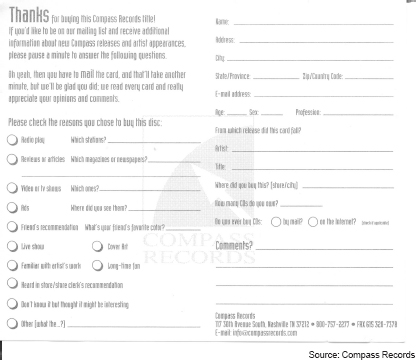
![]() Figure19.5 Customer reply card for Compass Records (Source: Compass Records)
Figure19.5 Customer reply card for Compass Records (Source: Compass Records)
Entire textbooks are devoted to survey design. The questions must be worded and presented in a clear, concise and unbiased manner to ensure validity. Measurement scales are developed to measure more abstract concepts such as personality and attitudes. These scales are banks of questions that have been carefully tested and found valid when applied appropriately to measure the concept they were designed to measure. If the survey has been judged to be valid and the sampling procedures are followed correctly, the results of the survey should convey a degree of confidence that the entire market or population exhibit the opinions and characteristics similar to those found in the sample.
Surveys are used extensively inside products to gather information on customers. Often the survey is part of the warranty card, but in the recording industry the cards are inserted in jewel boxes. The cards have different names depending upon the label; at some they are tossback cards, at others, bounceback cards, and still others may refer to them as customer response cards or business reply cards. The sample base for these cards should not be considered random or representative of the market overall. Sample bias may occur because consumers who send in the cards may be systematically different from customers who purchase the product but do not send in the cards. Nonetheless, the cards are beneficial in gaining an understanding of the market.
In the early to mid-1990s, Geffen Records was interested in learning more about young male music fans who were buying the metal and grunge recordings released by the label. Bounceback cards were placed inside specific releases and the results were analyzed to gain an understanding of the market. Label personnel were surprised that many of the fans read Rolling Stone and Spin magazines, rather than the heavy metal genre-specific magazines targeted to those consumers. A comparison of magazine preferences with geographic location (urban, rural, and suburban) led to the conclusion that these more specific magazines were not available on news racks in many locations and therefore not as popular. It was also learned for the first time that many of the grunge fans enjoyed skateboarding, and that tattoo parlors were a good place to promote heavy metal music.i (In today’s business climate, these findings are intuitive, but at the time they were not as obvious.) How did the label learn of the connection between their music and skateboarding? The skateboard magazine, Thrasher, kept showing up in the “top ten favorite magazines” listed by those who returned the bounceback cards. The label was also able to find out about the interest in vinyl recordings and usage of the Internet at that time. These types of findings help a record label make better decisions about where and how to market their products, and which media outlets to use.
Bounceback card for Geffen Sampler Buy Product
![]() Figure19.6 Figure 19.6 Bounceback card for Geffen Records (Source: Geffen Records, reprinted with permission)
Figure19.6 Figure 19.6 Bounceback card for Geffen Records (Source: Geffen Records, reprinted with permission)
When experiments are appropriate
Scientific experiments require that all variables be controlled. Variables are any factors that might influence the outcome. In the case of marketing, the outcome is sales of the recording. The various factors or variables that might influence this include any and all marketing efforts—radio airplay, TV performance, touring, in-store activities, local and national press coverage, word of mouth, and so forth. In a normal experimental setting, one or more of the variables would be manipulated, and the other variables would be held constant or controlled. For example, experimental research on the impact of television advertising on sales would involve at least two groups in the market that are identical in all aspects, except exposure to the advertising variable: a flight of commercials. Other factors that might influence sales would have to be kept identical for both groups. This is much easier to accomplish in a laboratory setting, but not practical for marketing research, since people do not shop in a vacuum.
Field experiments are conducted in a natural setting, despite the fact that complete control of extraneous variables is not possible. Attempts are made to find two groups of consumers that are alike in as many aspects as possible. Then one group may be exposed to a particular marketing strategy, while the other is not. This is not popular in the recording industry because it involves with holding some marketing efforts to a portion of the market during the crucial window for generating sales. Controlled store tests (or test marketing) may be conducted by providing products to some stores to gauge sales before investing in a nationwide product rollout. Results from this type of testing do not automatically generalize to the entire market and guarantee national success, due to other factors that may not have been accounted for during the controlled store tests.
The use of syndicated research
Since the introduction of SoundScan and BDS, the use of syndicated research has become a valuable tool for making marketing decisions in the record business. Chapter 6 illustrates how SoundScan data can be used as a basis for more in-depth research to detect sales trends and the impact of marketing strategies. Data from BDS can be merged with SoundScan to determine a more precise impact of radio airplay on record sales than was possible 15 years ago. SoundScan and primary research are combined for tour analyses, market profiles and to persuade radio stations to increase airplay. Data from SoundScan helps determine who (what geographic locations) to select for focus groups.ii The use of SoundScan, coupled with the business reply cards, syndicated research from other sources, and occasional focus groups, give marketing departments a better idea of the marketplace and allow for better prediction of marketplace performance of products.
Arbitron provides information on radio listening audiences, and much of that information is valuable to the record business. NARM and the RIAA conduct research projects and provide the results to its members. The U.S. Census Bureau provides basic demographic and geographic information that is used to develop marketing strategies. Other syndicated research services provide information about advertising effectiveness in general, and help marketers determine which media outlets to use to reach a particular market segment.
Research sources for record labels
Tracking services
Nielsen SoundScan is arguably the most important company providing research data and information to record labels. They are self-described as “an information system that tracks sales of music and music video products throughout the United States and Canada. Sales data from point-of-sale cash registers is col-lected weekly from over 14,000 retail, mass-merchant and nontraditional (online stores, venues, etc.) outlets.” Sales results can be compared with marketing efforts for evaluation of the impact of those marketing events.
Weekly data from sales are compiled by SoundScan and made available every Wednesday. “Nielsen SoundScan is the sales source for the Billboard music charts” (SoundScan, 2005). Nielsen also owns Broadcast Data Systems (BDS). BDS provides airplay tracking for the entertainment industry using a digital pattern recognition technology. “Nielsen BDS captures in excess of 100 million song detections annually on more than 1,200 radio stations in over 130 markets in the U.S.” (BDS, 2005). MediaBase also tracks radio airplay (see Chapter 8). In 2001, MediaBase joined efforts with Radio & Records to provide data for compiling their charts.
In the following example, the effects of artist appearances on Prairie Home Companion and the impact of the artist winning the Shure Vocal Competition at the Montreux Jazz Festival are evident in the sales patterns for jazz artist Inga Swearingen.
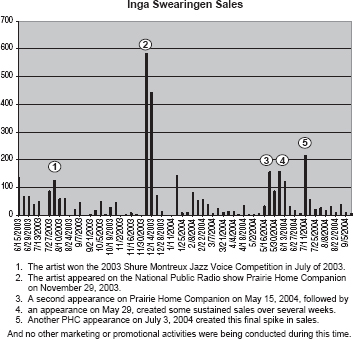
![]() Figure 19.7 Inga Swearingen Sales Spikes (Source: SoundScan)
Figure 19.7 Inga Swearingen Sales Spikes (Source: SoundScan)
Trade association research services
All the major trade organizations provide research for their members. NARM publishes its monthly Research Briefs, where they have worked with NPD and Ipsos for industry/technology information. NARM provides research findings at its annual convention on a variety of current and ever-changing industry topics. The RIAA provides annual data on shipments, and contracts with an outside research firm to conduct its annual consumer profile. For this project, nearly 3,000 music buyers are surveyed. The RIAA has worked with Taylor Research on a large-scale consumer research survey, with Pricewater-houseCoopers (PWC) on a study of shipments and returns, and NPD Digital for data on what consumers are doing in the digital area. The RIAA also provides research information on illegal downloading. The IFPI collects data from member countries and publishes an annual report called The Recording Industry in Numbers. The International Federation of Phonographic Industries (IFPI) also releases periodic reports on digital music and global piracy. Billboard publishes MarketWatch in its weekly magazine. The associations tend to conduct issue-oriented research of benefit to all members of the record industry.
Commercial research firms
Forrester Research is one of the leading market research firms focused on the Internet and technology, and conducts research for the recording industry on all aspects of music and the Internet. Forrester also offers custom research and consulting services to its clients. Jupitermedia Corporation is a leading provider of original information, images, research, and events for information technology, business and creative professionals. They are often hired by the associations to conduct and report on online music consumers. Edison Media Research is a leader in political, radio and music industry research with clients that include major labels and broadcast groups. Music Forecasting does custom research projects on artist imaging and positioning.
The NPD Group, which was recently acquired by Ipsos, provides marketing research services through a combination of point-of-sales data and information derived from a consumer panel. Their research covers music, movies, software, technologies, video games, and many other product groups. ComScore offers consulting and research services to clients in the entertainment and technology industries, and conducts audience measurements on website usage through its Media Metrix division. Taylor Nelson Sofres, a UK firm, provides both syndicated and custom research of media usage and consumer behavior. Based in France, IPSOS is a global group of researchers providing survey-based research on consumer behavior. BigChampagne (owned by Clear Channel), tracks online P2P usage and reports, among other things, most popular songs on P2P networks. ResearchMusic is an online music service that also offers free music market research to registered customers. OTX is an online consumer research and consulting firm.
Marketing research is a scientific process designed to ascertain information about consumers and their attitudes toward products. It follows a process of problem identification, exploratory research, the research design, data collection, analysis, and conclusions or recommendations. Since markets are always a moving target, and the recording industry is constantly releasing new and unproven products, marketing research has become a valuable tool enabling record labels to more accurately plan marketing strategies. The recording industry has embraced marketing research to a greater extent in the past 20 years as marketing has grown more competitive and sophisticated.
Marketing research – The systematic design, collection, analysis and reporting of data and findings relevant to a specific situation facing a company.
Sample – A small representative subsection of the market segment used as a basis for analysis in research.
Syndicated research – The gathering of continuous or periodic information which is sold in standardized form to all companies involved in the industry. Examples include Arbitron, Nielsen, BDS and SoundScan.
Custom research – Tailored, proprietary, initiated by a company, and often specific to a particular product developed by that company. Examples include product surveys, focus groups, customer satisfaction surveys and personal interviews.
Secondary research – Going over data that has been previously collected for a project other than this one at hand.
Exploratory research – Initial research conducted to clarify and define the nature of the problem.
Concept testing – A means of evaluating ideas by providing an early indicator of the merits of an idea prior to the commitment of resources to development and manufacturing.
Experiments – A form of research in which conditions are controlled so that (an) independent variable(s) can be manipulated to test a hypothesis about a dependent variable.
Descriptive research – Research designed to describe characteristics of a population or phenomenon.
Focus groups – Unstructured, free-flowing group interviews designed to gain a deeper understanding of consumer feelings, beliefs and attitudes.
Triangulation – The application and combination of several research methodologies in the study of the same phenomenon.
Instrument – A data collection form, such as a questionnaire, or other measuring device.
Coding – The process of identifying and assigning a numerical score or other character symbol to previously edited data.
Data analysis – The application of logic to the data, looking for systematic patterns and details that will answer the research questions.
Executive summary – A one or two page bulleted-list summary of the highlights of the findings, designed to be read by those people who need to know the main points but do not have time to read through the report to find them.
Research report – An oral presentation or written statement of research results, strategic recommendations, and/or other conclusions given to the marketing client.
Validity – The ability of a scale to measure what was intended to be measured.
Measurement scales – Any series of items on a survey that have been scientifically designed to measure or test a concept.
Bibliography
BDS (2005). http://www.bdsonline.com/about.html.
Blankenship, A. B. and Breen, G. E. (1993). State of the Art Marketing Research, Chicago: NTC Business Books.
SoundScan (2005). http://www.soundscan.com/about.html.
Tutor2U (2005). Market Research – Sampling. http://www.tutor2u.net/business/marketing/research_sampling.asp.
Zikmund, W. G. (1991). Exploring Marketing Research, Orlando: The Dryden Press. Zulkardi (2004). Triangulation in Educational Research. http://www.geocities.com/Zulkardi/submit3.html.
i Hutchison, Thomas. (1992–1997) primary research data.
ii Ury Greenberg, Linda. (February 21, 2005). Personal Interview.

